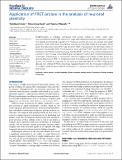Application of FRET probes in the analysis of neuronal plasticity
Author(s)
Ueda, Yoshibumi; Hayashi, Yasunori; Kwok, Show Ming
DownloadUeda-2013-Application of FRET.pdf (719.3Kb)
PUBLISHER_POLICY
Publisher Policy
Article is made available in accordance with the publisher's policy and may be subject to US copyright law. Please refer to the publisher's site for terms of use.
Terms of use
Metadata
Show full item recordAbstract
Breakthroughs in imaging techniques and optical probes in recent years have revolutionized the field of life sciences in ways that traditional methods could never match. The spatial and temporal regulation of molecular events can now be studied with great precision. There have been several key discoveries that have made this possible. Since green fluorescent protein (GFP) was cloned in 1992, it has become the dominant tracer of proteins in living cells. Then the evolution of color variants of GFP opened the door to the application of Förster resonance energy transfer (FRET), which is now widely recognized as a powerful tool to study complicated signal transduction events and interactions between molecules. Employment of fluorescent lifetime imaging microscopy (FLIM) allows the precise detection of FRET in small subcellular structures such as dendritic spines. In this review, we provide an overview of the basic and practical aspects of FRET imaging and discuss how different FRET probes have revealed insights into the molecular mechanisms of synaptic plasticity and enabled visualization of neuronal network activity both in vitro and in vivo.
Date issued
2013-10Department
Massachusetts Institute of Technology. Department of Brain and Cognitive Sciences; Picower Institute for Learning and MemoryJournal
Frontiers in Neural Circuits
Publisher
Frontiers Research Foundation
Citation
Ueda, Yoshibumi, Showming Kwok, and Yasunori Hayashi. “Application of FRET probes in the analysis of neuronal plasticity.” Frontiers in Neural Circuits 7 (2013).
Version: Final published version
ISSN
1662-5110